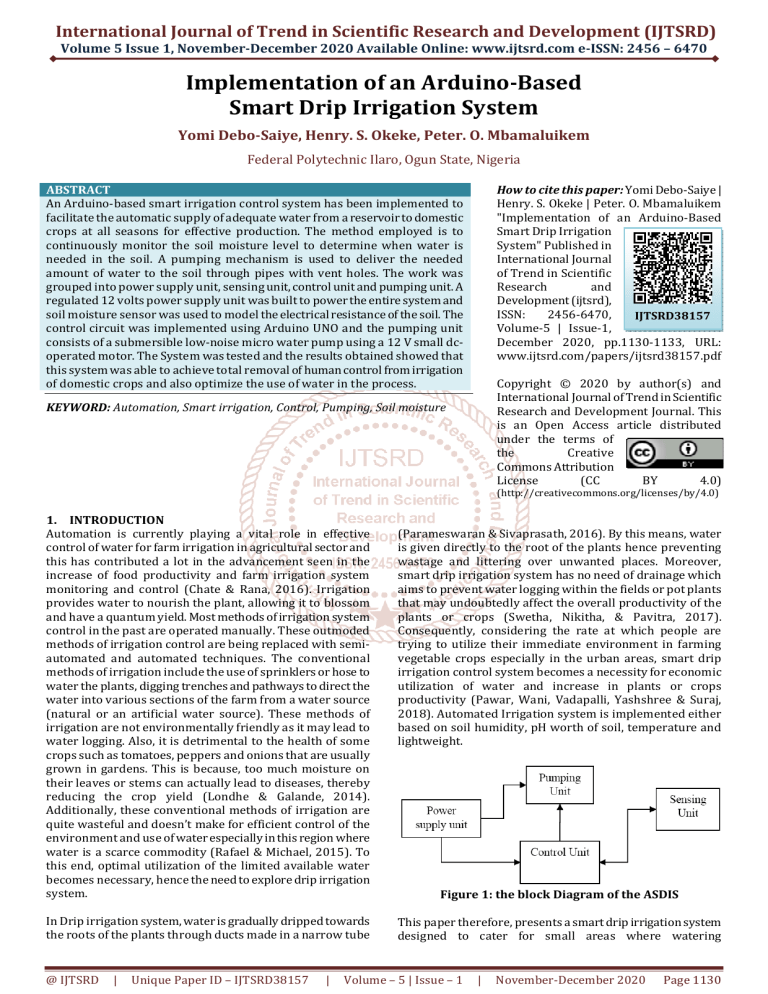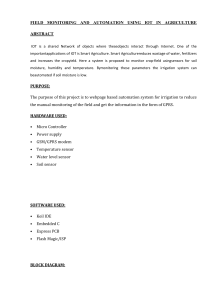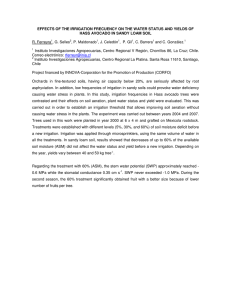
International Journal of Trend in Scientific Research and Development (IJTSRD) Volume 5 Issue 1, November-December 2020 Available Online: www.ijtsrd.com e-ISSN: 2456 – 6470 Implementation of an Arduino-Based Smart Drip Irrigation System Yomi Debo-Saiye, Henry. S. Okeke, Peter. O. Mbamaluikem Federal Polytechnic Ilaro, Ogun State, Nigeria How to cite this paper: Yomi Debo-Saiye | Henry. S. Okeke | Peter. O. Mbamaluikem "Implementation of an Arduino-Based Smart Drip Irrigation System" Published in International Journal of Trend in Scientific Research and Development (ijtsrd), ISSN: 2456-6470, IJTSRD38157 Volume-5 | Issue-1, December 2020, pp.1130-1133, URL: www.ijtsrd.com/papers/ijtsrd38157.pdf ABSTRACT An Arduino-based smart irrigation control system has been implemented to facilitate the automatic supply of adequate water from a reservoir to domestic crops at all seasons for effective production. The method employed is to continuously monitor the soil moisture level to determine when water is needed in the soil. A pumping mechanism is used to deliver the needed amount of water to the soil through pipes with vent holes. The work was grouped into power supply unit, sensing unit, control unit and pumping unit. A regulated 12 volts power supply unit was built to power the entire system and soil moisture sensor was used to model the electrical resistance of the soil. The control circuit was implemented using Arduino UNO and the pumping unit consists of a submersible low-noise micro water pump using a 12 V small dcoperated motor. The System was tested and the results obtained showed that this system was able to achieve total removal of human control from irrigation of domestic crops and also optimize the use of water in the process. Copyright © 2020 by author(s) and International Journal of Trend in Scientific Research and Development Journal. This is an Open Access article distributed under the terms of the Creative Commons Attribution License (CC BY 4.0) KEYWORD: Automation, Smart irrigation, Control, Pumping, Soil moisture (http://creativecommons.org/licenses/by/4.0) 1. INTRODUCTION Automation is currently playing a vital role in effective control of water for farm irrigation in agricultural sector and this has contributed a lot in the advancement seen in the increase of food productivity and farm irrigation system monitoring and control (Chate & Rana, 2016). Irrigation provides water to nourish the plant, allowing it to blossom and have a quantum yield. Most methods of irrigation system control in the past are operated manually. These outmoded methods of irrigation control are being replaced with semiautomated and automated techniques. The conventional methods of irrigation include the use of sprinklers or hose to water the plants, digging trenches and pathways to direct the water into various sections of the farm from a water source (natural or an artificial water source). These methods of irrigation are not environmentally friendly as it may lead to water logging. Also, it is detrimental to the health of some crops such as tomatoes, peppers and onions that are usually grown in gardens. This is because, too much moisture on their leaves or stems can actually lead to diseases, thereby reducing the crop yield (Londhe & Galande, 2014). Additionally, these conventional methods of irrigation are quite wasteful and doesn’t make for efficient control of the environment and use of water especially in this region where water is a scarce commodity (Rafael & Michael, 2015). To this end, optimal utilization of the limited available water becomes necessary, hence the need to explore drip irrigation system. In Drip irrigation system, water is gradually dripped towards the roots of the plants through ducts made in a narrow tube @ IJTSRD | Unique Paper ID – IJTSRD38157 | (Parameswaran & Sivaprasath, 2016). By this means, water is given directly to the root of the plants hence preventing wastage and littering over unwanted places. Moreover, smart drip irrigation system has no need of drainage which aims to prevent water logging within the fields or pot plants that may undoubtedly affect the overall productivity of the plants or crops (Swetha, Nikitha, & Pavitra, 2017). Consequently, considering the rate at which people are trying to utilize their immediate environment in farming vegetable crops especially in the urban areas, smart drip irrigation control system becomes a necessity for economic utilization of water and increase in plants or crops productivity (Pawar, Wani, Vadapalli, Yashshree & Suraj, 2018). Automated Irrigation system is implemented either based on soil humidity, pH worth of soil, temperature and lightweight. Figure 1: the block Diagram of the ASDIS This paper therefore, presents a smart drip irrigation system designed to cater for small areas where watering Volume – 5 | Issue – 1 | November-December 2020 Page 1130 International Journal of Trend in Scientific Research and Development (IJTSRD) @ www.ijtsrd.com eISSN: 2456-6470 plants/flowers at ordered interval like office premises, structures, house gardens, parks, hotels, etc., is needed using the moisture content as a control parameter with Arduino microcontrollers and C- programming language. 2. DESIGN METHODOLOGY The Arduino-based smart drip irrigation system (ASDIS) was designed to continuously sense the moisture level of the soil and use its status to determine when to water the soil with the precise required amount of water and then shuts the supply of water to the plants when the required level of soil moisture is achieved. The reference level of soil moisture content is adjustable for optimal determination of appropriate soil moisture content requirement for a particular plant. The block diagram of the system developed is shown in Figure 1. 3. SYSTEM DESIGN 3.1. Power Supply Power supply sometimes referred to as an electrical converter is an electrical device that supplies electrical power to an electrical circuit and/or load. The power supply chosen for this project is 12V. This is because the pump, relay and Arduino UNO uses 12 V as their input power supply (Dhakate et al., 2018). The power supply process is shown below. Figure 2: Power Supply Process. 3.2. DC Pump A DC pump uses the current from the power supply to draw fluid. It has two opening, one opening is used in drawing in the fluid (water) while the other is used to take out the fluid (water) draw. The DC pump used for this project is 12 V, 3.6 W (Aslinda &Sheng, 2019). 3.3. Arduino UNO It is a microcontroller board based on ATmega328P. It has 14 digital input and output pins, 6 Analog pins, a reset button, a power jack, a USB connection. In this project, the PIN 8 and PIN 13 were used. PIN 8 was connected to the soil moisture sensor to extract the state of the soil moisture information and PIN 13 was connected to the relay for its operation and control (Parameswaran & Sivaprasath, 2016). @ IJTSRD | Unique Paper ID – IJTSRD38157 | 3.4. Soil Moisture Sensor Conventionally, a sensor receives an analog input and converts it to a digital output. The moisture content is the physical parameter which is converted into electric signal and the Soil moisture sensor measures the moisture content of the soil (Sonali, Dinesh & Rojatkar, 2015). The output terminal of the sensor used are the VCC, GND and the D0 (digital output 0). The D0 takes the digital output from the sensor and feeds it to the microcontroller. 3.5. Electronic Relay It is a type of electronic switch that is capable of opening and closing a circuit without any mechanical movement. The output of the relay has the NO, NC and COM terminals. The NO and the COM terminals were used such that if the operation satisfies the required condition, the NO terminal closes which allows a flow of current thereby activating the pump to perform its required operation(Aslinda& Sheng, 2019). 4. Flow Diagram of Proposed System The operation of ASDIS follows the following flowchart: Figure 3: the flow Diagram of ASDIS Volume – 5 | Issue – 1 | November-December 2020 Page 1131 International Journal of Trend in Scientific Research and Development (IJTSRD) @ www.ijtsrd.com eISSN: 2456-6470 4.1. Circuit implementation The implementation of the electronic circuitry involved physical simulation of the circuit using a breadboard to ensure proper operation and the implementation of the circuit on a Vero board. The connection of ASDIS is as shown in Figure 4. Figure 4: The Connection Circuit of ASDIS From Figure 4, it is seen that the 240 V mains power supply is connected to the 240/12 V transformer of the power supply unit. The channel relay board has three pins on the relay board namely normally open (NO), normally closed (NC) and customary (C). The most popular pin is linked to NC pin once the relay is off and also to the NO pin once the relay is on. The input pin “INP” receives logic high from Arduino UNO as well as in turn switches around the relay, thus common is linked to NO which turns the unit on up until the relay is on. The “VCC” and “GND” pins from the relay are linked to 5 V supply and ground correspondingly. Figure 5 shows the breadboard configuration RESULTS AND DISCUSSION The system was tested using a pot of sandy soil as a sample, the result is shown in Figure 5. The ASDIS was also tested in clay and loamy. Figure 6 and Figure 7 shows the result of ASDIS performance on clay and loamy soil respectively. Figure 5: Graph of ASDIS performance on sandy soil Figure 6: Graph of ASDIS performance on clay soil @ IJTSRD | Unique Paper ID – IJTSRD38157 | Volume – 5 | Issue – 1 | November-December 2020 Page 1132 International Journal of Trend in Scientific Research and Development (IJTSRD) @ www.ijtsrd.com eISSN: 2456-6470 Figure 7: Graph of ASDIS performance on loamy soil In results obtained from the implementation of ASDIS on sandy, clay and loamy soil, it is observed that there is a directly proportional relationship between the level of soil dryness and the duration in which the water flows during irrigation. The irrigation water flows for 1.5s, 2.3s and 1.3s in sandy, clay and loamy soil when the soil dryness is 50%. While at 70% soil dryness the duration of irrigation is 2.5s, 7s and 6s for sand, clay and loamy soil. Then finally when the soil is 100% dry the duration of irrigation is 4.3s. 13s and 11.5s for sand, clay and loamy soil. The dryer the soil the longer the duration of irrigation. CONCLUSION Arduino-based smart drip irrigation control system has been implemented. The prototype of the system worked according to specification and quite satisfactorily. The components for its implementation are readily available and affordable. The system helps to eliminate the stress of manual irrigation control while at the same time preserving the available water supply. This system improves irrigation efficiency, hence contributing greatly towards improving the production of agricultural products. The system was tested and from the result, the performance of the system can be adjudged satisfactory. For future work on this project, we recommend that for a large-scale implementation a more powerful water pump can be used. Also, IoT technologies and cameras can be employed to enable remote control and monitoring of the farm which will help to monitor the soil moisture and to control the application of water to the agricultural products thereby saving water and increase production. REFERENCES [1] Aslinda Hassan, Siah Bing Sheng, W. M. S. and N. B. (2019). Chapter 1. An Automated Irrigation System Using Arduino Microcontroller, 1908(January), 2–6. [2] Chate, B. K., & Rana, J. (2016). SMART IRRIGATION SYSTEM USING RASPBERRY PI. International Research Journal of Engineering and Technology, 3(5), 247 - 249. @ IJTSRD | Unique Paper ID – IJTSRD38157 | [3] Dhakate, K., Kambe, S., & Meshram, S. (2018). A Review on Arduino Based Smart Irrigation System. 4(2), 623–630. [4] Londhe, G., & Galande, S. (2014). Automated Irrigation System By Using ARM Processor. International Journal of Scientific Research Engineering & Technology, 3(2), 254-258 [5] Muñoz-Carpena, R., & Dukes, M. D. (2015). Automatic irrigation based on soil moisture for vegetable crops. Nutrient Management of Vegetable and Row Crops Handbook, 173. [6] Parameswaran, G., & Sivaprasath, K. (2016). Arduino Based Smart Drip Irrigation System Using Internet of Things. International Journal of Engineering Science, 5518(5), 5518–5521. https://doi.org/10.4010/2016.1348 [7] Pawar, R., Wani, K., Vadapalli, L., Yashshree, P., & Suraj, P. (2018). An Astute Irrigation System With Crop Management And Marketing. International Journal of Computational Intelligence & IoT, 2(3). [8] Sonali D. Gainwar, Dinesh V. Rojatkar. Soil Parameters Monitoring With Automatic Irrigation System. IJSETR, Volume 4, Issue 11,November 2015 [9] Swetha, R. N., Nikitha, J., & Pavitra, B. (2017). SMART DRIP IRRIGATION SYSTEM FOR CORPARATE FARMING-USING INTERNET OF THINGS. International Journal of Creative Research Thoughts, 5(4), 1846 - 1851. Volume – 5 | Issue – 1 | November-December 2020 Page 1133



